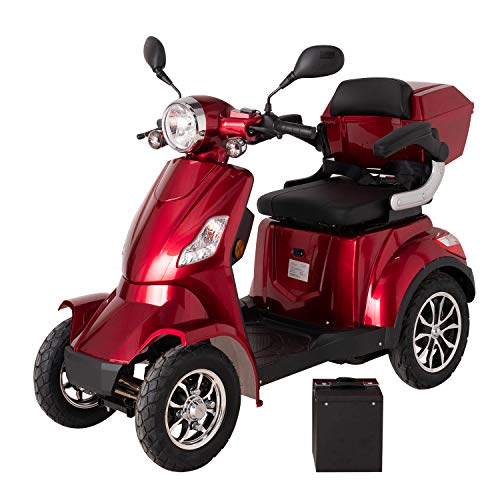Is a Green Mobility Scooter Really Green?
The transport sector is the second-largest contributor to greenhouse gases emissions. Are electric scooters that dock on shared streets really green?
Scooter startups like Tier, Dott, Voi and Circ all claim to be sustainable. are. We asked them about their sustainability strategy. Here's what they said. Dott's warehouses are powered with 100% renewable energy, and its fleet is 80% electric.
What is a green Scooter?
A green mobility scooter is a scooter that is powered by electricity which is generally less polluting than gasoline or other fossil fuels. Electric scooters that are rental via apps have been gaining popularity in many cities across the globe. They're an efficient and simple method of traveling without vehicles. However, are these scooters actually green? This is the question that we will try to answer in this article.
To answer this question, we must consider the different phases of a vehicle's cycle. These are its manufacturing phase (how polluting it is to extract raw materials, transform them and construct the vehicle) and its energy production phase (how much pollution is created when it is charging). There is also the use phase of the scooter and its final phase (how it is maintained and then recycled or destroyed after it ceases to work).
The most recent study on this subject was conducted by researchers from North Carolina State University. Researchers from North Carolina State University discovered that electric scooters emit an average of 141 g CO2 per mile and a passenger when driven throughout their entire life. This is still 2 times higher than driving an electric vehicle. The problem is, in reality, that the majority of scooters are used for a couple of months before they are destroyed and then discarded or reused.

For this reason, we aren't convinced that scooters are environmental green. If people opt to ride scooters instead of cars they'll have to replace them with more eco-friendly transportation methods such as public transport and cycling. In the end, scooters today are not an alternative to more eco-friendly vehicles, and they do not contribute in reducing Eugene's carbon footprint or greenhouse gas emissions.
Green Power Scooters
If you're looking for green scooters to help you stay mobile and independent you won't be disappointed with one of the Green Power models. They all have a good quality construction and are class 3 mobility scooters which means they're road legal. They also include free VIP aftercare and support for 12 months.
All Green Power scooters are extremely affordable and boast excellent green energy credentials. The GP Unique 500 is a ideal choice for those looking for a green scooter that can go up to 45 miles on one charge. It also comes with an additional lithium battery upgrade.
The greatest feature of a green motorbike is that it's durable. This means that you can ride on rough terrains but still enjoy smooth rides. The Green Transporter Cheeta Ninja has off-road turf wheels that can easily handle dirt, grass and sand. They can also handle hills, with a maximum incline of 35 degrees.
One thing to keep in your mind is that these are heaviest mobility scooters available which is why you'll need help to lift and store them when not in use. If you are a single person, or have a small family, it may not be feasible to purchase a large-duty scooter. It's also important to take into consideration how much you are going to be driving them, and whether you are able to carry them in your vehicle for trips out and around. If not, it could be better to opt for an easy-to-fold model. They are much easier to transport and keep in storage.
Class 3 Scooters
These scooters are ideal for people who can walk but aren't keen on it. These scooters feature a powerful motor and a larger battery. They can travel up to 8 mph, which makes them a great choice for long-distance trips. The suspension system is designed to offer a comfortable ride on rough terrain.
While they are more expensive than Class 2 models these mobility scooters give you the independence that many people desire. These scooters are ideal for those who wish to travel further distances or visit family and friends, or take part in activities that they might otherwise not be able to do.
A class 3 scooter is able to be driven on the road however you'll be required to adhere to the Highway Code. In contrast to motorbikes and cars, you do not need license to operate one. greenpower mobility scooters is however recommended to pass the driving test to ensure you are safe and confident when operating the scooter.
The class 3 model is also better suited to rough terrain as it is more robust and has more power. It is able to climb hills and cope with steep slopes, allowing you to explore new places and participate in outdoor activities that you were unable to do before.
If you're considering a mobility scooter of class 3 we suggest visiting our Lewes showroom to experience the various features in person. Our staff can help you select the right model for your needs and guide you through your purchase. We offer free home installation and a range of extra gifts to help make your scooter more efficient and enjoyable. You can also try out a range of models at our showroom.
3 or 4 Wheel Scooters
If you're looking to purchase the latest mobility scooter there are two main designs to consider: 3-wheel and 4-wheel. The differences between these two are subtle, but they are important to consider when selecting the best model to suit your specific needs and lifestyle.
The most obvious major difference is the radius of turning which is the measurement of the amount of space needed for a full circle. This is important for people who spend a lot of time in tight areas. For instance, a 3-wheel scooter could have 10 inches less turning radius than its four-wheel counterpart.
3-wheel mobility scooters are also typically smaller and have a slim base which makes them more maneuverable in tight spaces. In actual fact, the ability to make a precise turn with nimbility is among the most significant advantages of this type of scooter. If you're in the middle of a crowded grocery store aisle or navigating down an alleyway, this feature comes in handy.
A 3-wheeler can also provide more legroom. This is due to the absence of two front wheels, and is an advantage for taller individuals or those suffering from leg and knee injuries.
The 4-wheel scooters on the other side, are designed to be more adaptable and can be used indoors as well as outdoors. They have a wider turning radius than 3-wheel scooters, but many can still fit through standard doorways. They are more stable and can be an ideal choice for those who struggle with balance. A 4-wheel mobility scooter is equipped with larger wheels that can handle rougher outdoor terrain.
Safety Features
Green Transporter has a number of scooters designed with safety in mind. The company offers a range of mobility scooters, with the most popular one being the enclosed Cheeta Ninja scooter. This lets the user enjoy a safe ride in any weather. With a weight of 550 pounds capacity it can be capable of accommodating two people and still provide a comfortable ride. It also has a Delta tiller, a front storage compartments and more.
The growing popularity of powered micro-mobility cars could lead to changes in the incidence of accidents, and there is the need to modify methods of analysis for accidents and preventive actions (Botton, Takagi, Shlez, Yechiam, & Rosenbloom, 2022). This requires a thorough understanding of their use patterns and the interactions between various kinds of infrastructure.
One example is the presence of electric scooters in public spaces with different speed limits, which could increase their accidents rates compared to private ones. This is evident in simulations that compare the g-force applied to those who use the use of a passive safety system. The prototype created by CESVIMAP makes use of a thermoplastic substance that can be deformed to reduce the energy transfer in an accident by as much as 85%.
Another example is the interaction between e-scooters and vulnerable road users on different kinds of infrastructure. This could range from a regular traffic interaction to a collision or conflict dependent on the spatial and temporal position of both road users and their speed regimes (Brown, Klein, Thigpen, & Williams, 2024). It is therefore crucial to determine the possibility of new accidents, their causes and to establish a set of guidelines for the transportation industry.
